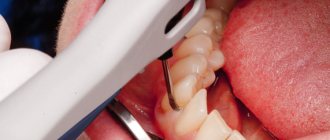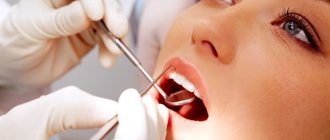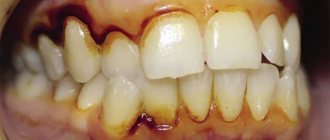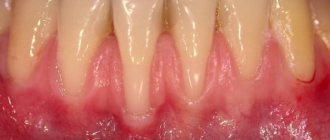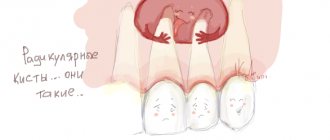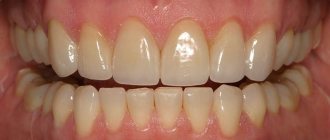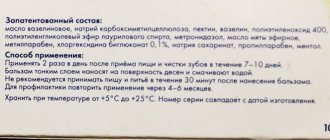September 9, 2017
Periodontitis is the number one cause of tooth loss. This disease is characterized by inflammation of the gums and tissues around the teeth, that is, the ligaments that hold them in the alveoli or sockets. The main cause of periodontitis is plaque, which we do not completely clean with a toothbrush or even leave on our teeth after eating. Gradually it mineralizes and turns into hard stone. Such deposits are located at the base of the teeth, and often completely penetrate under the gums. Toxins produced by hard plaque microorganisms lead to inflammatory processes. Therefore, the most important thing to do when treating periodontitis is to remove all deposits.
Periodontitis
UltraSmile . ru I decided to talk about the most effective, according to many dentists, method of cleaning periodontal pockets - gum curettage. What kind of operation is this, how it is performed and whether it really helps to cure the disease is below in our material.
What are periodontal pockets?
When brushing your teeth poorly, a soft plaque forms on their surface. Gradually it hardens and turns into stone. If such deposits are not removed in a timely manner, they penetrate deep under the gums. As a result, periodontal pockets are formed, in which the gums peel away from the surface of the tooth. In such cavities, food debris, microbes and bacteria accumulate, which actively affect the roots of the teeth and the surrounding bone tissue. Very often the deposits rot, causing extremely bad breath, and the pus can even spread throughout the body.
Periodontal pocket
Professional cleaning in dentistry
There are several ways to clean your teeth and gums in the dental office. Depending on the individual characteristics and preferences of the patient, the doctor will help you choose the most effective and safest method for removing dental plaque.
Mechanical gum cleaning
Mechanical cleansing remained the only cleansing method for a long time. There are two ways to carry it out:
- manual cleaning (curettage);
- sandblasting.
Manual cleaning is carried out using special tools, allowing you to clean the teeth under the gums and clean periodontal pockets of stubborn tartar deposits. The procedure is used extremely rarely due to pain and the likelihood of damage to the enamel.
Sandblasting - removing plaque and stone with a powerful jet of water solution with soda. For this purpose, a device is used that supplies a stream of air and water with abrasive particles of soda, which remove the remaining deposits and at the same time polish the surface of the tooth enamel.
Chemical method of cleaning teeth
Chemical cleaning of gums in dentistry is considered a safe and painless procedure. Its essence lies in the use of chemical compounds (hydrogen peroxide and hydrochloric acid), which are applied to areas that require cleansing and then removed.
At the stage of preparation for the procedure, it is necessary to use protective material to avoid injury to the gums.
The advantages of the method include:
- painlessness;
- removal of even old deposits;
- brightening of tooth enamel.
Disadvantages of the procedure:
- likelihood of allergic reactions;
- risks of soft tissue damage from chemicals;
- increased tooth sensitivity.
Chemical cleansing is contraindicated for people suffering from diseases of the respiratory system, pregnant or lactating women, as well as persons under 18 years of age.
Laser gum cleaning
Cleaning gums and teeth using this method involves the use of laser radiation to remove old plaque. Using a special device, the doctor directs a laser beam to the place of accumulation of hardened contaminants, destroying them, and then washes them away with a stream of water-air mixture.
The method allows you to clean hard-to-reach places from deposits, whiten teeth, strengthen enamel and gums, and prevent the development of caries.
Contraindications to laser gum cleaning are hypersensitivity, pregnancy, inflammation of the mucous membrane and wearing braces.
Ultrasound cleaning – the choice of dentists
Ultrasonic cleaning is an alternative method to outdated methods of removing deposits. Its essence lies in the use of a device that emits ultrasonic waves that hit the surface of the enamel and clean it. Teeth brushing parameters (depth, frequency and amplitude of waves) are set individually, which allows you to achieve the best effect.
The method is considered safe, does not damage the enamel and has minimal impact on the teeth and gums.
How is gum curettage performed?
There are two types of surgical intervention in the treatment of periodontitis: closed and open gum curettage. The operation is performed under anesthesia and lasts quite a long time - about 2 hours. In this case, about 7-8 teeth can be treated in one visit.
Closed gum curettage
Closed curettage is not a surgical procedure and is more reminiscent of regular professional cleaning. Its effectiveness is high if the periodontal pockets are shallow - no more than 3 mm. With this method, the doctor uses instruments with a thin hook on the tip (curettes) - he lowers them under the gum, manually removes deposits and cleans out periodontal pockets. At the same time, ultrasonic vibrations, air-abrasive treatment, laser and simply ordinary water are used, which is supplied under pressure (to wash out crushed stone from under the gums). But this method has a drawback - the dentist cleans the pockets blindly and cannot check whether the granulation tissue has been completely removed. There is a significant risk that the inflammation will start again. That is why in case of periodontitis it is recommended to carry out curettage using open technology.
Closed gum curettage
Open gum curettage
This method already refers to a full-fledged surgical intervention. Its essence boils down to the fact that to clean periodontal pockets, the gums are exfoliated - this allows you to expose the roots of the teeth and carry out more thorough scraping. The operation must be performed under anesthesia. After making an incision in the gums, the doctor uses ultrasonic equipment, a laser or hand instruments; after removing all granulations, the neck or bare roots of the tooth must be polished with a professional brush with a high speed of rotation of the head - less bacteria will accumulate on the smooth surface. In case of severe destruction of bone tissue, a synthetic analogue is placed into the cavity. Next, the gums are returned to their place and sutures are applied (usually self-absorbing).
Open gum treatment
It is open curettage of the gums that is the most effective measure for cleansing periodontal pockets in moderate and severe forms of periodontitis. By exfoliating the gums, the doctor has access to all subgingival deposits - they can be removed without residue, which will reduce the risk of re-infection to a minimum.
Flap surgery
This operation is almost identical to open gum curettage, with the only difference being that part of the atrophied gum is additionally cut off. When voluminous gum pockets form, the mucous membrane often changes so much that even after suturing it will not fit tightly to the surface of the tooth. Therefore, the best option for restoring aesthetics would be to trim the mucosa to correct its shape and position.
Treatment of gums with injections and medications
In some cases, injections of various medications may be required. Antibacterial medications are prescribed strictly individually. In any case, the clinic doctor will not ignore his patient’s dental problem. As evidenced by reviews of our clinic in Moscow, we are always ready to help!
Restoration of teeth and gum tissue in our clinic includes the use of antibiotics and antibacterial drugs. The action of therapy is aimed at eliminating the source of inflammation and stopping the disease. Powerful antiseptics Actovegin and Solcoseryl are used, which have an epithelializing effect. In acute cases, physiotherapy is prescribed.
Vacuum and finger massages are also used as an additional method of therapy. Such measures allow blood to circulate better in the affected areas and trigger the necessary recovery processes.
Important!
Regular dental hygiene should be performed to prevent the formation of mineral deposits and the development of disease.
What are the pros and cons of gum curettage?
Compared to professional oral hygiene, open curettage has quite clear advantages:
- better access to deposits due to gum peeling,
- absence of relapses - when curettage of the gums the doctor opens the entire area for work, he can make sure that all granulations are removed,
- it is possible to restore damaged bone tissue,
- with simultaneous drug therapy and splinting of teeth, it is possible to achieve stable results in the treatment of periodontitis,
- correction of the appearance of enlarged gums.
Among the disadvantages of the surgical operation is the impossibility of performing it in patients with purulent discharge, with extreme pathological mobility of teeth, acute infectious diseases, and also in cases where there is intolerance to painkillers. In addition, among the disadvantages of curettage is the rather high cost of the open technique. The cost of cleaning periodontal pockets in the area of 1 tooth is from 1.3 thousand rubles.
After surgery, the patient needs to be prepared for the gums to change their shape and even position. Very often, after cleaning periodontal pockets, plastic surgery is required to correct the aesthetics of the gums. The roots of the teeth may become exposed, and the gingival papillae also droop slightly, but after a few months they increase in size and take on the desired shape.
Gum disease - periodontal disease
Although periodontal disease is a gum disease, it has nothing in common with either gingivitis or periodontitis. Periodontal disease is especially often confused with periodontitis: this is due to the fact that periodontal disease also exposes the necks of the teeth. However, with periodontal disease there is no dental plaque, purulent inflammation and periodontal pockets. Moreover, these diseases have completely different pathogenesis. The exact causes of periodontal disease have not yet been determined, but most experts believe that the disease is formed as a result of metabolic disorders, chronic diseases of internal organs, lack of normal blood supply to soft tissues and poor heredity. One thing is good: periodontal disease is considered a fairly rare disease that occurs in no more than 10% of people. Since the disease is not inflammatory in nature, the treatment of periodontal disease has its own characteristics.
After the operation
After curettage of the gums, the patient needs to strengthen oral hygiene, promptly removing pathogenic microbes - they can lead to infection of the wounds. In the first days, you should refrain from eating hot or cold, as well as too hard foods. Be sure to rinse with antibacterial drugs and herbal solutions. In the first few hours, cold compresses can be applied to the outside of the face to relieve swelling. You should drink through a straw to avoid causing seams to split.
After surgery you should drink through a straw.
It is worth noting that gum curettage gives your teeth a chance to last for many more years. Do not wait until the process becomes irreversible, and seek help from a dentist in time!
Laser gum treatment
Elimination of periodontal problems in our clinic is also carried out using laser equipment. The method allows you to deeply disinfect all gum tissue and the oral cavity. The laser has a powerful regenerating effect. Its use is safe and appropriate for periodontitis. The procedure has fewer contraindications and is accessible to most of our patients. After the procedure, rehabilitation is faster and easier. Laser restoration of teeth and gum tissue is an innovative method that is widely used in Europe.
Therapy is carried out in a course prescribed by the doctor. Already after the first procedure, partial restoration of tissue cells occurs. The laser provides non-contact, minimally invasive dental care and positive results. The technology allows a specialist to eliminate all problems with the disease, as well as eliminate stomatitis and gingivitis. Our specialists are fluent in new technologies and methods for eliminating dental problems.
Complex treatment has a more positive result. The use of antibacterial medications, laser exposure, and surgical curettage make it possible to forget about the disease. Statistics show that complex therapeutic methods are 65% more effective than monotherapy.
Watch the video of closed gum curettage
Notice
: Undefined variable: post_id in
/home/c/ch75405/public_html/wp-content/themes/UltraSmile/single-item.php
on line
45 Notice
: Undefined variable: full in
/home/c/ch75405/public_html/wp-content /themes/UltraSmile/single-item.php
on line
46
Rate this article:
( 1 ratings, average: 5.00 out of 5)
gum disease
Consulting specialist
Uspangalieva Nina Borisovna
Doctor rating: 9.5 out of 10 (6) Specialization: Dentist-therapist Experience: 12 years
About what curettage is
Curettage is a surgical operation whose purpose is to remove plaque and tartar covered with bacterial deposits from under the gums. Without this procedure, further treatment of periodontitis and periodontal disease is ineffective, because if the plaque is not removed, the inflammatory process on the gums will be impossible to stop.
The procedure can be performed using hand tools, a laser, or an ultrasonic scaler. Upon completion, the patient can also simultaneously undergo augmentation of bone tissue that has atrophied as a result of the course of the disease.
Main stages of treatment
With gingivitis, inflammation of the marginal part of the gums develops. If the cause of the disease is failure to comply with hygiene rules, which has led to the formation of tartar and plaque, the dentist carries out professional cleaning. After removing the deposits, he polishes using abrasive pastes, which will prevent the deposits from reappearing. Then the doctor treats the inflamed gums with antiseptic agents, applies medicinal bandages, and, if necessary, prescribes anti-inflammatory therapy and vitamins. After treatment, he selects toothpaste, a brush, mouthwash for the patient, and also teaches him how to properly brush his teeth.
Periodontitis is characterized by inflammation of the gums and ligaments, destruction of periodontal fibers and bone tissue, and the appearance of periodontal pockets with the accumulation of pus and subgingival deposits.
At the initial stage of the disease, professional cleaning is carried out and anti-inflammatory drugs are used. In severe cases, surgical intervention is prescribed to remove deposits from the roots and eliminate the pathology of the periodontal pocket. To avoid tooth loss and loosening, orthopedic methods are used that involve tying together healthy and diseased teeth.
Periodontal disease is a non-inflammatory disease of the periodontal tissue. For treatment, medicinal (putting antiseptic ointments in pockets under the gums, taking antibiotics), physiotherapeutic (electrophoresis, massage) and surgical (prosthetics, splinting and laser therapy) methods are used.
